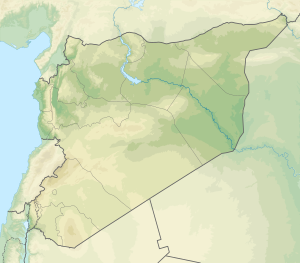
Back تل أبو هريرة Arabic تل ابو هريره ARZ Tell Abu Hureyra Catalan Abu Hureyra Danish Tell Abu Hureyra German Tell Abu Hureyra Spanish Tell Abu Hureyra Basque Tall Abu Huraira Finnish Tell Abu Hureyra French תל אבו הוריירה HE
تل أبو هريرة | |
| Location | Raqqa Governorate, Syria. |
|---|---|
| Region | Lake Assad |
| Coordinates | 35°51′58″N 38°24′00″E / 35.866°N 38.400°E |
| Type | settlement |
| History | |
| Founded | c. 11,000 BCE |
| Abandoned | c. 5,000 BCE |
| Periods | Epipaleolithic—Neolithic |
| Cultures | Natufian culture |
| Site notes | |
| Excavation dates | 1972–1973 |
| Archaeologists | Andrew M. T. Moore, Gordon Hillman, Anthony Legge |
| Condition | flooded by Lake Assad |
Tell Abu Hureyra (Arabic: تل أبو هريرة) is a prehistoric archaeological site in the Upper Euphrates valley in Syria. The tell was inhabited between 13,300 and 7,800 cal. BP[1] in two main phases: Abu Hureyra 1, dated to the Epipalaeolithic, was a village of sedentary hunter-gatherers; Abu Hureyra 2, dated to the Pre-Pottery Neolithic, was home to some of the world's first farmers.[2] This almost continuous sequence of occupation through the Neolithic Revolution has made Abu Hureyra one of the most important sites in the study of the origins of agriculture.
The site is significant because the inhabitants of Abu Hureyra started out as hunter-gatherers but gradually moved to farming, making them the earliest known farmers in the world.[2] Cultivation started at the beginning of the Younger Dryas period at Abu Hureyra. Evidence uncovered at Abu Hureyra suggests that rye was the first cereal crop to be systematically cultivated. In light of this, it is now believed that the first systematic cultivation of cereal crops was around 13,000 years ago.[3]
During the Late Glacial Interstadial, Abu Hureyra site experienced climatic change.[2] Due to lake level changes and aridity, the vegetation expanded into lower areas of the fields. Abu Hureyra accumulated vegetation that consisted of grasses, oaks, and Pistacia atlantica trees.[2] The climate changed from warm and dry months to abruptly cold and dry months.[3]
- ^ Cite error: The named reference
:3was invoked but never defined (see the help page). - ^ a b c d Cite error: The named reference
Moore2000was invoked but never defined (see the help page). - ^ a b Hillman, Gordon; Hedges, Robert; Moore, Andrew; Colledge, Susan; Pettitt, Paul (27 July 2016). "New evidence of Lateglacial cereal cultivation at Abu Hureyra on the Euphrates". The Holocene. 11 (4): 383–393. Bibcode:2001Holoc..11..383H. doi:10.1191/095968301678302823. S2CID 84930632.

